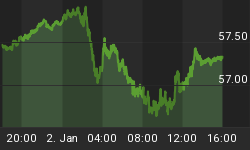Stocks Break Above Twelve Year Base
The market's recent shift back into economically sensitive assets tells us stocks could continue their surprising march higher despite the ongoing calls for "sell in May". As shown in the chart below, the S&P 500 made no progress during the last twelve years. The "no progress" pattern was recently broken, which could lead to head-scratching gains in the months ahead.

Market Has Responded To Economic Data
The financial markets were pleased with the widely-anticipated monthly employment report that was released in early May. Monday's session was greeted with a better than expected number on the retail front. From Bloomberg:
Sales at U.S. retailers unexpectedly advanced in April, helping ease concern of a sustained pullback in consumer spending that would stifle the economy. Retail purchases climbed by the most in four months minus receipts from service stations, where cheaper gasoline prices depressed the dollar value of sales.
Confirmations More Upside Likely
In the world of chart reading, known as technical analysis, "confirmations" occur when two or more charts support the same conclusion. Breakouts can fail. Therefore, we would feel more confident about the S&P 500's recent twelve year breakout if other charts and areas of the market seem to fall in the bullish line. This week's video covers twenty areas of the market that align with or serve as a "confirmation" of the S&P 500's recent march higher. Chart analysis begins at the 2:43 mark.
Volume Confirms Market's Push Higher
When large market players, such as hedge funds, place a bet, they make large trades which are reflected in daily and weekly trading volume. When we track volume, we are indirectly tracking where the "big boys" are placing their bets. The chart below ($NYUD) shows more volume has been associated with advancing stocks relative to declining stocks, which is another way of saying the big boys have been more interested in buying rather than selling. Notice how $NYUD, like stocks, has broken above a multiple-year base.

Breadth Regains Bullish Footing
The period between late January and mid-April 2013 was marked by a defensive bias in the markets, despite the S&P 500's advance. The defensive undertones can be seen in the chart of market breadth below. Market breadth speaks to the percentage of stocks participating in a rally. When a high percentage of stocks participate (strong breadth), it is a sign of a healthy market. Conversely, when breadth is weak, it casts doubt on a rally's staying power. Notice how the concerns about weak breadth have been removed since the Summation Index ($NYSI) reversed sharply in mid-April.

Shift Back Toward Cyclical Stocks
Cyclical stocks tend to be more sensitive to the strength of the economy. One example is Harley-Davidson (HOG). Rational people tend to put off the purchase of a $15,000 motorcycle if they are concerned about job security. The chart below shows economically sensitive stocks (SPHB) were weak relative to defensive stocks (SPLV) during the ten week period between early February and mid-April of this year. Since then, the market's tone has shifted noticeably in the bulls' favor.

Small Caps Show Growing Confidence
Small caps are another area of the markets that is shifting back toward the "we're confident" end of the spectrum. When investors migrate back toward smaller (read riskier) companies, it signals renewed hope for positive economic outcomes.

Intermediate-Term Outlook Positive
Even the under the most bullish conditions, stocks experience various forms of backfilling. Therefore, if the bullish signals above remain in play, we should still expect pullbacks from time to time. However, the odds favor a continuation of the longer-term trend, which is bullish.
Investment Implications
As long as conditions outlined above remain in place, we will favor cyclical areas of the market over defensive sectors. Cyclical ETFs include high beta (SPHB), consumer discretionary (XLY), retail (XRT), technology (QQQ), semi-conductors (SMH), home builders (ITB), energy (XLE), financials (XLF), small caps (IWM) and mid-caps (MDY). Defensive sectors tend to underperform under these conditions, meaning we would tend to avoid or underweight consumer staples (XLP), utilities (XLU), and healthcare (XLV).
Major Wild Card: Fed Policy
There is absolutely zero question the Fed's aggressive money-printing and bond-buying programs have played a major role in the market's recent advance. A not-so-subtle objective of the Federal Reserve's use of quantitative easing (QE) is to boost asset prices. If the Fed dials back its bond purchases and the markets react in a negative manner, the entire investment landscape could be flipped upside down. Monday's Wall Street Journal paints a very uncertain picture relative to the Fed's exit strategy, especially on the timing front:
Officials say they plan to reduce the amount of bonds they buy in careful and potentially halting steps, varying their purchases as their confidence about the job market and inflation evolves. The timing on when to start is still being debated.
Should the markets have a Fed-induced return to "risk-off" mode, the charts above will experience an observable change in character. In a world where asset prices are heavily impacted by intervention from central banks, maximum flexibility is an ongoing requirement for investors.
















